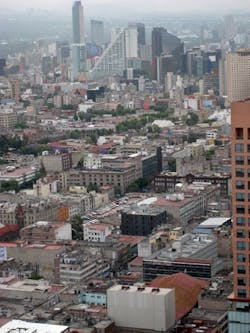Energy prices are increasing, there’s an increasing dearth of skilled labor – especially for airline pilots and truck drivers – while government regulations and budget deficits threaten to choke off economic growth and infrastructure improvements.
That’s quite a “worry list” of issues for the transportation and logistics (T&L) industry; a list compiled from the broad 17th Annual Global CEO Survey conducted by global consulting firm PricewaterhouseCoopers (PwC).
PwC surveyed 1,344 business leaders across 68 countries in the last quarter of 2013, conducting further in-depth interviews with 34 of those CEOs. Within that mix, PwC did some digging into the T&L sector to find what worries the CEOs of firms that move goods within the U.S. as well as worldwide.
[For example, here are some thoughts from Brian Molefe, group chief executive of Transnet SOC Ltd., based In South Africa.]
PwC noted that over the past several years, T&L CEOs have consistently been less optimistic about future revenue growth than their business peers from other industries – and that’s true this year, too, as only 45% believe the global economy will improve in 2014. Indeed, T&L CEOs are much more worried about sluggish growth in the advanced economies (43%) than about a slowdown in emerging markets (39%), according to PwC’s poll.
Energy continues to be a big worry as well, noted PwC, as trains, planes, ships and trucks all rely on fuel. Thus it’s not surprising that T&L CEOs continue to worry more about high or volatile energy costs than do their colleagues across the overall survey sample, the firm said. Here are some of the details:
- In the last survey, 61% of T&L CEOs were somewhat or extremely concerned about energy costs, but that’s jumped to 76% in this survey.
- Since 2001 the price for crude oil has risen fourfold. Ongoing high oil prices will lead to an increased use of alternative fuels, like liquefied natural gas (LNG).
I traded emails with Jonathan Kletzel (seen below at right), PwC’s U.S. transportation & logistics leader, to get some deeper insight into the T&L fears regarding energy and he stressed to me that a couple of different things are in play here.
“New fuel sources are certainly helping the U.S. with its energy prospects but this was a global survey so the geo-political uncertainty in key energy regions continues to be a stress point,” he explained.Kletzel also stressed that switching from petroleum to natural gas is a costly investment for most fleet operations and in many cases the return-on-investment (ROI) horizon is still too far out to make sense for that investment. Also, the refueling infrastructure and networks for natural gas are not as developed as they are for petroleum. “And not all transportation modes (i.e. aircraft) can use natural gas to power their vehicles,” he emphasized.
Regarding fears of higher petroleum costs, Kletzel pointed out that most of the polling got done during the third and fourth quarters of 2013, which was just after a pretty significant run up in crude oil prices.
“So energy costs were more likely to have been top of mind as a concern because of the (at that point) recent increase in impact on profitability,” he explained. “Also with crude oil generally up since late 2013, the concern is unlikely to have abated much in the eyes of executives since the surveys were taken.”
On another front T&L CEOs, like their peers overall, are concerned about the ability of debt-laden governments to tackle soaring deficits. It’s a worry that’s been increasing over the past several years, with 66%, expressing about government responses to debt and deficits.
“I would also add that government budgets are strained in many Western countries, which is making it more difficult to grow infrastructure spending,” Kletzel said. “Infrastructure privatizations can be an answer, but these can also be difficult to pull off in some cases given concerns about employment and the long-term nature of the contracts.”
Yet he stressed such concerns vary by mode and by geography. “In the U.S., government – that is federal, state, and local – investment in infrastructure (roads, airports, railroads, etc.) is down. Private investment is there in as much as companies see buying opportunities for infrastructure on the cheap, but it doesn't mean they are investing in infrastructure renewal.”
More broadly, PwC found that half of T&L sector CEOs would like to see the government make infrastructure investment a priority, with 42% believing that governments have been effective at improving country infrastructure and 43% noting that their companies are taking direct responsibility, too, in infrastructure investments. Still, 56% are worried that basic transportation infrastructure is not adequate today.On the regulation side, nearly two-thirds (68%) of T&L CEOs believe taxes could sidetrack growth prospects, with that same percentage concerned that excessive regulation could put the brakes on growth. Regulatory restrictions cited by T&L companies ranged from carbon emission regulations to road tolls or restrictions on toll-free road usage, noted PwC.
T&L CEOs highlighted five “big trends” in PwC’s survey that they believe will “transform” their businesses in the coming five years.
The top one cited by nearly four-fifths (79%) of them centered on technological advances such as the digital economy, social media, mobile devices and big data. More than half also pointed to demographic fluctuations (53%) and global shifts in economic power (59%), with resource scarcity and climate change (51%) followed up by urbanization (50%) rounding out the list.
Some 43% of T&L CEOs polled by PwC said they are concerned about the speed of technological change and while that’s lower than the overall sample of business leaders, that’s probably because few see product and service innovation as their main route to growth, PwC said.
Still, most sector CEOs want to improve their company’s ability to innovate, with 75% aiming to alter their research and development (R&D) functions, while 89% are exploring better ways of using and managing big data and 82% are changing their technology investments.
Yet there’s a “glaring gap” between aspiration and action, PwC determined, with for example only 17% of T&L CEOs stating that they’ve already started or completed the changes they’re planning to make their companies more innovative.The composition of the global population is changing radically and that’s going to have a big impact on the T&L sector, especially in terms of finding the right labor skills for their business functions..
By 2025, the population will hit 8 billion, noted PwC, but this growth won’t be homogeneous – indeed, some countries are seeing a decline in fertility rates. Complicating this scenario is that the number of city dwellers is expected to rise by 72% of the next four decades, with this trend in “urbanization” producing an enormous impact on both T&L networks as urban areas get more congested, requiring new mobility strategies.
Thus the need for new and improved “talent,” of which 62% of T&L CEOs are worried won’t be available. Another 46% of T&L CEOs believe that creating a skilled workforce should be a government priority, but only 21% believe that the government has been effective. As a result, many say they are taking action themselves, with 62% noting that creating a skilled workforce is a priority for them.
“Talent is one of the main engines of business growth. So one of the biggest issues CEOs face, as these huge demographic changes occur, is finding and securing the workforce of tomorrow – particularly the skilled labor they need to take their organizations forward,” PwC noted in its research. “For T&L, there are major shortages looming in some key professions like pilots and truck drivers. And logistics skills are in short supply in many countries.”
Kletzel added that this “talent shortage” problem varies by mode in the U.S. but in general there are several trends at work here:
- Finding skilled labor continues to be a challenge for companies that operate in remote areas (i.e. freight rail)
- For younger talent, T&L companies lack the allure of tech companies and startups
- T&L companies are lower margin businesses and have a hard time with competitive labor rates
- A large number of boomers are retiring and the replacement workforce is just not there
“I would also note that there is more competition from a rebounding construction industry in the US and some other regions,” he stressed. “In addition, there are more shale-related energy job opportunities in the US that the transportation sector now has to compete with."
That all adds up to quite a lengthy – and detailed – laundry list of concerns T&L firms will have to overcome in the next few years. It will be interesting to see what solutions they develop, too.



